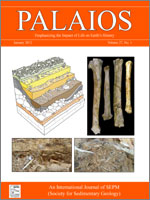The water vapor conductance (GH2O) of the neosauropod eggs from the Lower Cretaceous Sanagasta nesting site in La Rioja Province, Argentina, was examined and compared with other Cretaceous Argentinean oological material. The 2900 mgH2O/day·Torr GH2O of the Sanagasta eggshells confirms an extremely moist nesting environment and supports field observations of dug-out nests in a geothermal setting. The observed thinning of the outer eggshell surface during incubation increases gas conductance and concomitantly decreases eggshell mechanical resistance during the late ontogenetic stages, thus facilitating embryonic development and hatching. The Sanagasta and Entre Ríos Province faveoloolithid eggs display the highest and comparable GH2O values and share several morphological and diagenetic characters, indicating comparable nesting strategy in geothermal settings. However, the faveoloolithid Yaminué and La Pampa Province specimens cluster together with lower GH2O values closer to the megaloolithid eggs. The GH2O of the megaloolithid egg Megaloolithus patagonicus was reconsidered and new results are now congruent with other reported megaloolithid GH2O values. Additionally, we hypothesize that Y-shaped pore canals of M. patagonicus, which upper sections reach only the top third or half eggshell thickness and, a wider section in the middle would not compromise the overall egg mechanical resistance like vertical pores connecting directly the outer to the inner eggshell surfaces. Such pore spatial arrangement and geometry would enhance, as the eggshell thins during incubation, a greater GH2O, GO2 and GCO2 and facilitate embryonic development in high moisture nesting contents. Overall, data suggests that neosauropod nesting and brooding behaviors were dependent on elevated moisture nesting environments.
BioOne.org will be down briefly for maintenance on 17 December 2024 between 18:00-22:00 Pacific Time US. We apologize for any inconvenience.
How to translate text using browser tools
1 January 2012
WATER VAPOR CONDUCTANCE OF THE LOWER CRETACEOUS DINOSAURIAN EGGS FROM SANAGASTA, LA RIOJA, ARGENTINA: PALEOBIOLOGICAL AND PALEOECOLOGICAL IMPLICATIONS FOR SOUTH AMERICAN FAVEOLOOLITHID AND MEGALOOLITHID EGGS
GERALD GRELLET-TINNER,
LUCAS ERNESTO FIORELLI,
RODRIGO BRINCALEPE SALVADOR
ACCESS THE FULL ARTICLE
It is not available for individual sale.
This article is only available to subscribers.
It is not available for individual sale.
It is not available for individual sale.

PALAIOS
Vol. 27 • No. 1
January 2012
Vol. 27 • No. 1
January 2012




